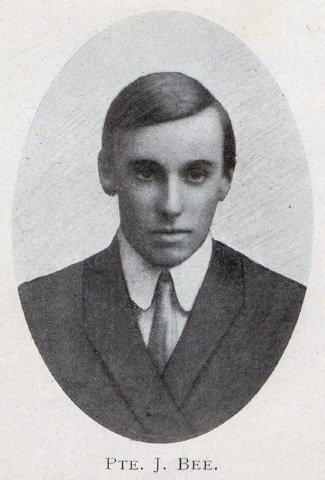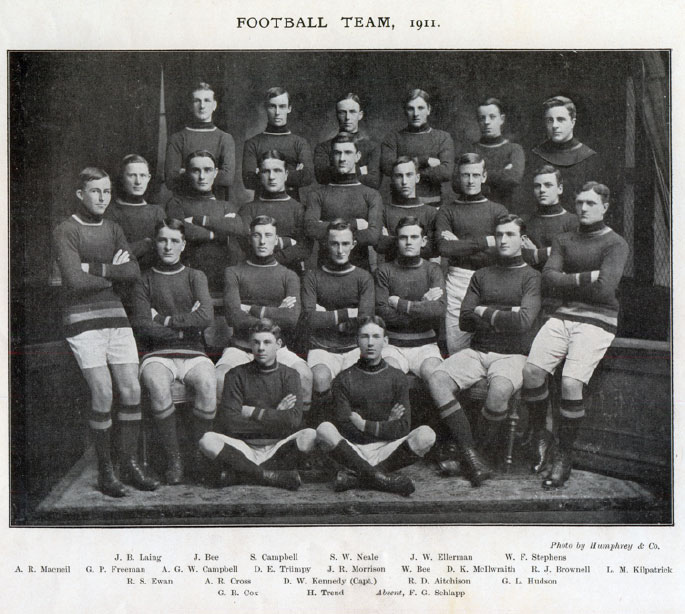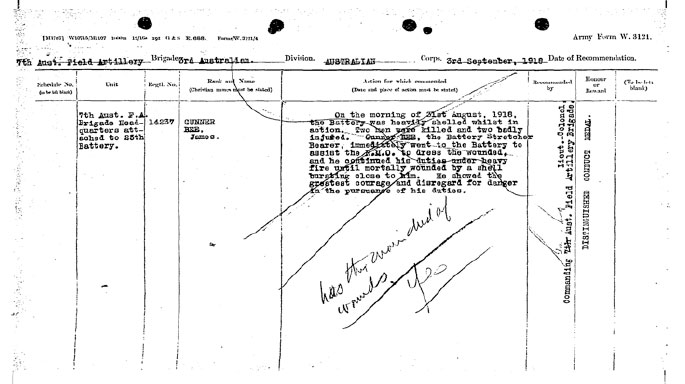War Memorial Hall c1929

James 'Jim' BEE

Jim Bee was born on 12 September 1891 in Wellington, New Zealand. His parents were Jim and Wilhelmina Bee. He attended Scotch from 1907 to 1911. Jim was a member of the 1911 First XVIII, which won the football premiership. His father was the former headmaster of Presbyterian Ladies’ College, Melbourne and, during Jim’s service, Headmaster of The Scots College, Sydney.
Jim was a university student when he enlisted on 25 October 1915 at Holsworthy, New South Wales. He served in the Australian Army Medical Corps, 10th Field Ambulance and 7th Field Artillery Brigade with the rank of Private. His Regimental Number was 14237.
Jim died on 31 August 1918 at Mont St Quentin, France. He was 26 years of age.
Service record
On enlistment Jim was allotted as a Private to the Army Medical Corps, probably as a stretcher-bearer. While remaining in that corps, in May 1916 he was attached to the 7th Field Artillery Brigade. He was twice hospitalised in England, for three weeks in September-October 1916 with influenza or pleurisy and then for a week in December 1916 with a sore throat. He recovered and travelled from England to France on 29 December 1916. He was taken on strength of the 10th Field Ambulance in France on 10 February 1917, and detached to the 7th Field Artillery Brigade. He apparently decided to leave the Medical Corps, for on 28 February 1918 he transferred from the 10th Field Ambulance to the 7th Field Artillery Brigade, now as a Gunner in the 25th Battery.
His obituary in The Scotch Collegian said that Jim chose to stay with the 7th FAB, and his mates, when ambulance men were being recalled to their medical units. It appears that his role was battery stretcher-bearer. His decision to stay may have cost him his life. He was wounded in both legs by an enemy shell on 31 August. He was taken to the 10th Field Ambulance, his former unit, where he died that day.
A poignant document is a recommendation made for Jim to receive the Distinguished Conduct Medal (see below). It explains the circumstances of his mortal wounding thus: ‘On the morning of 31st August, 1918, the Battery was heavily shelled whilst in action. Two men were killed and two badly injured. Gunner BEE, the Battery Stretcher Bearer, immediately went to the Battery to assist the R.M.O. [Regimental Medical Officer: unit doctor] to dress the wounded, and he continued his duties under heavy fire until mortally wounded by a shell bursting close to him. He showed the greatest courage and disregard for danger in the pursuance of his duties.’ Handwritten over the typed page are the words ‘Has the man died of his wounds[?]’ and the answer ‘Yes’. The typed words of the recommendation are crossed through in pen or pencil, indicating that Jim Bee was ineligible for a DCM. That award could not be given posthumously.
Captain Cedric Sampson, who had been RMO with the 7th FAB from 1915 to June 1918, knew Jim well. He wrote that Jim ‘was fatally wounded about 6.30 a.m. on the 31st while in the execution of his duty, endeavouring to dress a wounded man while the battery was under heavy shell fire. I got him away to the A.D.S., where every effort was made to save his life, but his injuries were so severe as to make the matter hopeless from the start.’ He then spoke of Jim’s qualities: ‘The greatest tribute one can pay him is to say that he was loved and relied on by every man in the battery. He was my right-hand man, and a true friend. Fearless to the point of recklessness, proud of the fact that no fire was too hot to prevent his getting to a wounded man, he died as he would have wished, doing a man’s work in a man’s way.’ Jim Bee’s epitaph, inscribed on his headstone at his father’s request, is: ‘Greater Love/ Hath No Man Than This/That A Man Lay Down His Life/For His Friend’.
Jim Bee is buried in the Hem Farm Military Cemetery (Plot II, Row C, Grave No. 14) Hem-Monnacu, France.
Photographs and Documents:

Jim Bee is second from the left in the back row of this photograph of the First XVIII of 1911. His twin brother Will is in the second row from the back. Stanley Campbell, Stan Neale, Keith McIlwraith, and Graham Cox would also be killed in the war.

The recommendation that Jim Bee receive a Distinguished Conduct Medal for his courageous work helping the wounded in the action that took his life. The recommendation was unsuccessful: the medal could not be awarded posthumously.
Sources:
- Australian War Memorial – Roll of Honour and Honours and Awards
- Mishura Scotch Database
- National Archives of Australia – B2455, BEE J
- Scotch Collegian 1919
- The AIF Project - https://www.aif.adfa.edu.au/showPerson?pid=18351


